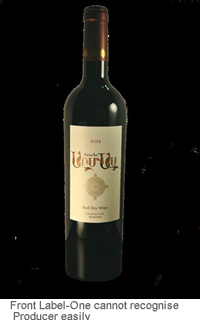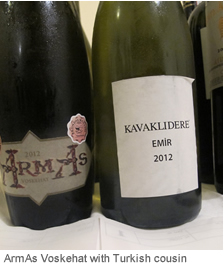|
Photos By: Adil Arora
 The young and charming CEO, Victoria Aslanian was in upbeat mood as she rose to address the audience at the seminar on Armenian Wines. The very first vintages of three of their premium wines -Rosé, Semi-Sweet, and Red Dry Wine had received Silver, Bronze, and Commended respectively at this year’s Decanter World Wine Awards in June. Prime Minister of Armenia, Hovik Abrahamyan had visited their modern Golden Grape ArmAs Winery in Aragatsotn Region the previous month. The young and charming CEO, Victoria Aslanian was in upbeat mood as she rose to address the audience at the seminar on Armenian Wines. The very first vintages of three of their premium wines -Rosé, Semi-Sweet, and Red Dry Wine had received Silver, Bronze, and Commended respectively at this year’s Decanter World Wine Awards in June. Prime Minister of Armenia, Hovik Abrahamyan had visited their modern Golden Grape ArmAs Winery in Aragatsotn Region the previous month.
She claimed in her presentation that Armenia was the oldest wine producing country in the world. Although Russia had designated her country as a brandy producer to meet the Russian demand during its control from 1922-1991 (Georgia was the designated red wine supplier), the Armenians had kept up the tradition of wine making and today they are already exporting wine to countries like Russia and Germany, she said.
Indigenous grapes used in Armenia and the terroir make the wines unique and interesting Some of the red grapes grown in Armenia are Karmarahyut, Kakhet, Areni and Meghrabuyr and the white popular varieties are Kangun, Rkatsiteli and Voskehat. International varieties like Pinot Noir, Pinot Blanc and Aligoté are also a part of the national portfolio. Interestingly, the wines tasted from her winery at lunch and at the Tasting Room later in the evening with their Italian winemaker were surprisingly delicious, well- made and fresh. Voskehat 2012 ArmAs-produced from Voskehat indigenous grapes was a good example of an elegant, juicy, white wine with golden colour.
The company founded by her father Armenak Aslanian in 2007 on his return from the US where he lived for several years, has been cultivating vineyards on over 200 hectares of land. Wine, brandy and table grape varieties are being developed, with 40 hectares of land reserved for orchards of peach, plum, apple, apricot and cherry. The winery has had Italia experts design the winery and installed modern equipment manufactured by the Italian Granzotto Company. brandy and table grape varieties are being developed, with 40 hectares of land reserved for orchards of peach, plum, apple, apricot and cherry. The winery has had Italia experts design the winery and installed modern equipment manufactured by the Italian Granzotto Company.
Francois Mauss, organiser of the Villa d’Este Wine Symposium, who is always scouting around different wine regions to decide on a different ‘Country of Honour’ at each Symposium, visited Armenia including the ArmAs winery last year. He was so impressed with the wine region, terroir, hospitality and of course the quality of their wines that he decided to choose Armenia as the country of honour. He tells delWine, ‘every year, we try to present a wine producing country which is not so well-known-such as Croatia, Slovenia, Hungary, and Turkey. This year we selected Armenia since some archaeologists discovered a 6,100 year old Armenian cellar, a proof that it is the oldest country of grape cultivation. In future we plan to look at Russia, Bulgaria and who knows… perhaps India one day!’
Known as the birthplace of the vine, Armenia is now considered as perhaps the origin of wine grapes. This designation has both a biblical testimony and an archaeological confirmation. According to the Old Testament, Noah’s Ark came to rest at the peak of Mount Ararat in Armenia. As the water subsided, Noah and his sons journeyed down to valleys of modern day Armenia, and upon recognition of the fertile soil in this unique terrain, they planted the first vines.
In 2010, carbon dating of remains discovered by archaeologists in the Areni-1 Cave complex, proved Armenia to be the site of the world’s oldest-known wine production facility, dating back to 6,100 years. The remains of grapes, seeds, and dried vines of Vitis Vinifera varieties were also found at this location.
What I found hard to digest was the artistic ArmAs logo on the bottle in the shape of several snakes and ladders like figure, presumably in the Armenian language with the ArmAs stuck unobtrusively on top. As Victoria explains proudly, it is an illustration of Armenian miniature art, architectural ornament and Christian faith. However, it did not leave a lasting impression on me for Brand Recall. Hopefully, non Armenians would find a connection of the artwork with the brand-howsoever Armenian and festive in looks or the company will have a rather bold ‘ArmAs’ imprinted on the front label.
France may be one of the biggest wine producers today but Armenia is the cradle of winemaking and it should restore the traditions, re-establish its image and take its rightful place on the global viniculture map”, says Victoria. It took France about 300 years to do it, but Armenia can achieve similar results in a decade, she believes. Of course, the Armenians need technical help from foreign winemakers like the Italian winemaker Emilio del Medico for ArmAs.
 Dr José Vouillamoz, co-author of Wine Grapes with Jancis Robinson MW and Julia Harding MW, who was a speaker at the last year’s edition of VDEWS, has visited the ArmAs winery. ‘Pure, with great personality, focused on indigenous varieties, they truly represent the Armenian terroir!’ he says about the wines. Dr José Vouillamoz, co-author of Wine Grapes with Jancis Robinson MW and Julia Harding MW, who was a speaker at the last year’s edition of VDEWS, has visited the ArmAs winery. ‘Pure, with great personality, focused on indigenous varieties, they truly represent the Armenian terroir!’ he says about the wines.
Armenian wines have not made any presence in India yet. But Armenia has had a business contact with India for the last 2500 years. Armenians are known to have settled down over centuries, the last flock being during the infamous genocide period by the Turks in the pre-1922 decade. There are churches in Kolkata and streets with Armenian names in Chennai, said K.K. Venugopal, senior Supreme Court Advocate who was also attending the World Wine Symposium. Unfortunately, most have left and only around 100 Armenians are now left in Kolkata.
The beauty of nature, their history and exquisiteness and the Indo-Armenian historical connections beckon the wine loving Indian travellers to visit Armenia and of course ArmAs Winery. Victoria Aslanian whose winery name ArmAs is a synthesis of her father’s (and Armenia) name, would like to export their wines to India. But she is also very keen to visit India-especially Kolkata and Chennai to find out more about Armenians in India and the Indo-Armenia friendship and ties. Looking for an importer to introduce her wines would give her another reason to visit India.
For an earlier related article World’s Oldest Winery Discovered by Archaeologists click here:
World’s Oldest Winery Discovered by Archaeologists
Subhash Arora |